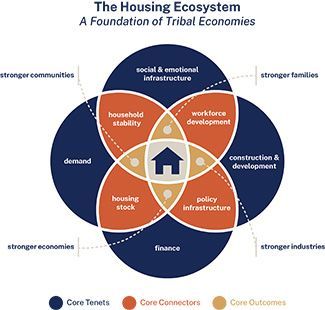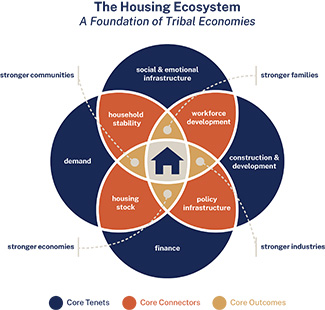Enterprise strongly believes home should be a place of pride, power, and belonging and a pathway to upward mobility for all. Our Tribal Nations team works diligently to create systemic opportunities and frameworks to guide the delivery and outcomes of our work toward this goal in the Tribal and Native communities we serve.
Introduction
The Housing Ecosystem supports holistically strengthening Tribal families, communities, industries, and economies. This resource was created to help our team, and the communities we serve, understand the multiple facets of creating housing and homeownership.

We recognized the dynamic intersection between each core element, including their dependencies on each other as well as the propelled opportunities for exponential growth when each element is healthy and mature. The Housing Ecosystem has been featured in presentations to our partners, at conferences, and has become the source of diagnosis as well as a guide for strategic growth.
The Housing Ecosystem in Tribal Economies affects Native Americans both on- and off-reservation. The journey of Native Americans to homeownership, because of the intricate history, trauma, and discrimination of Native peoples in the United States, is not linear, is not static, and cannot exist outside the context of Native communities and identity. The Housing Ecosystem shows the cyclical nature of housing within the Native landscape while offering a deeper understanding of the key focus areas imperative to the Native housing journey.
Demand
The demand for housing within Tribal economies relates to more than a consumer’s desire and willingness to purchase housing. It relates to the value systems and ways of being for Tribal people and recognizes that desires creating demand stem from deeply rooted value systems.
Other factors like limited jobs, industry, and policy infrastructure on Trust land impact the purchasing power of on-reservation Natives. Multi-generational living, overcrowding, and hidden homelessness, as well as lower-quality housing stock also impact the demand for homeownership.
Off-reservation, Native Americans are still experiencing disproportionally lower rates of homeownership. Though these households are more likely to be incorporated into housing preparedness and stability programming, these resources often do not include culturally aware provisions, resulting in a widening chasm in access to homeownership.
The identified demand, or market, for Native homeownership is a socio-economic phenomenon. It is as much tied to a sense of value, belonging, and connection as it is to economic and community factors.
Social and Emotional Infrastructure
The handling of money and the acquiring of assets is as emotional as it is financial. For Native communities processing generational trauma, a restoration of empowerment, belonging, and vision in alignment with generational value systems is a critical component of a healthy housing ecosystem.
Progressive housing development and robust homeownership programming are enabled only when a community holds the social and emotional infrastructure to uphold a community vision for homeownership within both lawmakers and citizens.
Tribal leadership must prioritize and support the full spectrum of housing services, from homelessness to homeownership, within their communities. They must foster the cultural connections that bring people into the community as well as the policy infrastructures needed on Trust land to make homeownership a competitive option for citizens living on-reservation.
For relatives living off-reservation, organizations providing housing stability interventions are rarely Native-led and face funding challenges when focusing services on Tribal citizens as well as Natives without legal status due to differences in Fair Housing practices.
Both on- and off-reservation housing providers must intentionally facilitate a feeling of pride in place for those who seek homeownership, motivating the homeowner to maintain and grow their asset.
Construction
For on-reservation Tribal citizens, an important element of the Housing Ecosystem is the development & construction of the physical structures. This includes the physical infrastructure needed for housing and utilities, as well as the legal and procedural infrastructure necessary to execute quality development on Trust land with various sources of capital.
Creating a robust construction and development sector must begin with the available local labor supply, and then lean on other parts of the ecosystem to facilitate workforce development programming that supports the labor needs of construction projects. Too often, this work begins with attempts to secure contractors and laborers who can come to the reservation, rather than prioritizing a grass-roots movement to build the local, tribal workforce.
Additionally, forward-thinking planning must also be incorporated, ensuring that housing jobs are maintained, and the changing needs of a community are being met. By keeping construction and development inclusive of the local economy, the Tribe gains additional economic impact beyond increased housing stock.
The construction multiplier effect – the theorem stating that every $1 spent on construction generates $3 in a closed economy – allows more benefits to remain in the economy when leadership utilizes labor, materials, and buyers from the local community.1
Financing
The final principle of the Housing Ecosystem encompasses the financial components necessary for on- and off-reservation Natives to successfully develop and purchase homes. Tribal Nations and Native organizations are historically underfunded.
Lands held in trust with the federal government, or land that is highly fractionated as a result of damaging federal Indian policies, create a financing barrier and negatively affect a community’s ability to develop infrastructure like wastewater and roads to support housing development. Though technically, trust lands within the boundaries of the reservation can be collateralized, they are not valued in the same way as the same lands off-reservation, and the traditional path to a positive equity position from land valuation is stunted.
On-reservation, traditional financial products and systems struggle to aptly navigate land leasing processes and to integrate with Tribal jurisdiction over legal processes such as foreclosure and building codes. While there are a few mortgage products that can serve trust lands, there are few lenders consistently and broadly experienced and engaged with these markets. This means there is limited opportunity for prospective homebuyers to access these products, and even less opportunity to compare terms or shop for better rates and lower down payments.
Unfortunately, efforts to engage off-reservation Natives with financial systems misaligned with Native values or perspectives frequently result in services that are disproportionately challenging for prospective Native American homebuyers. This can heavily impact first-time homebuyers and cost-burdened families and even higher-income, low-risk households struggle to find services and products to meet their needs.
Conclusions
A holistic view of the entire housing ecosystem, including the tensions and intersections between the core elements, is required to approach the creation and implementation of well-balanced solutions effectively. Pathways to success are successful only when they address each core element of the housing ecosystem in light of the modern challenges of today’s economic climate.
Solutions must be comprehensive and honor the diversity of Native identity and experience within North America. The Housing Ecosystem allows our Tribal Nations team, in partnership with the communities we serve, to first identify the barriers and opportunities to achieve a healthy housing ecosystem, and then develop strategies and plans to restore housing stability and economic power.
1 Residential Construction Economic Study 5-2020 (leadingbuilders.org)

- Documents